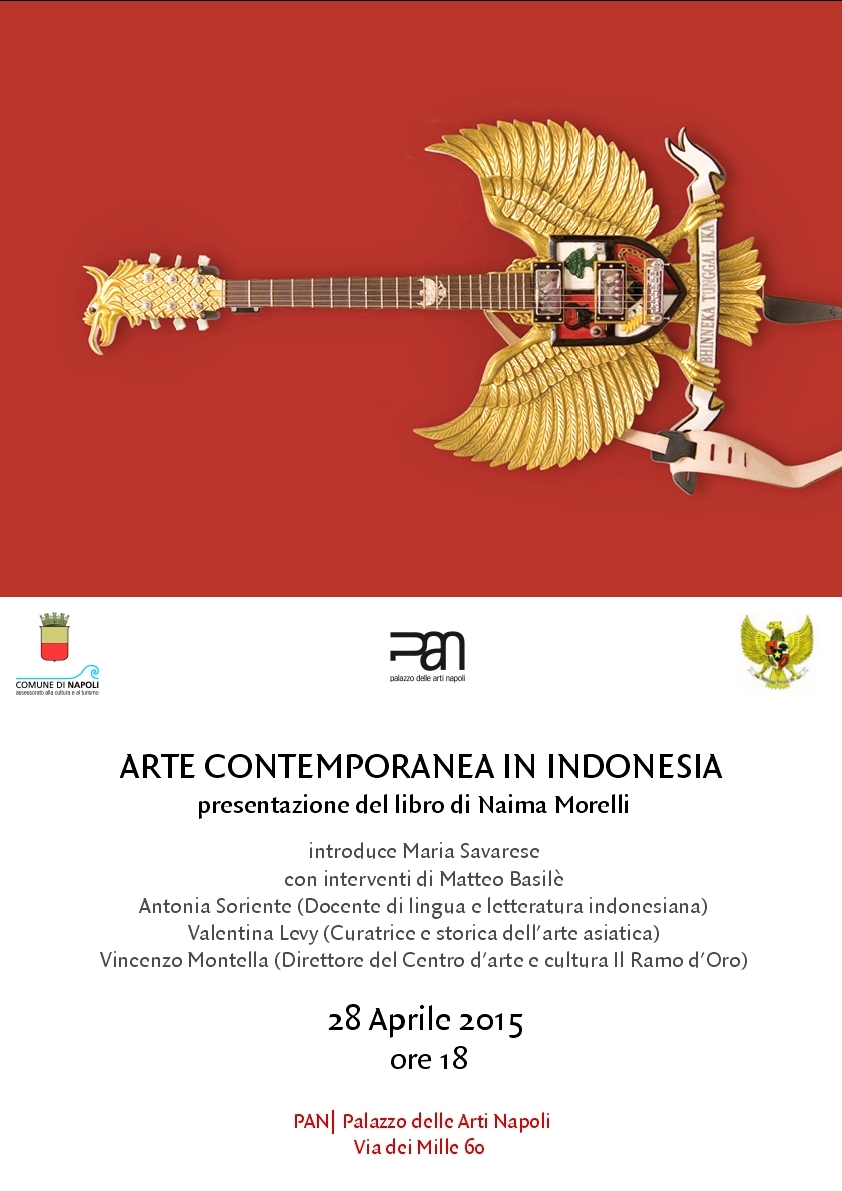
Yesterday we presented my book “Arte Contemporanea in Indonesia, un’introduzione” in Naples at the PAN|Palazzo delle Arti Napoli. It has been great to hear how the curators and professors who partecipated analyzed my book from their own personal perspective and background. Their approaches made me reconsider my research from new angles. It was bit surreal too, I’ve to admit. Like, is it really the work of this Sorrentinean brat over here they are talking about?

Tuesday, April 28 at 6pm PAN | Palazzo delle Arti Napoli will host the presentation of the book “Arte Contemporanea in Indonesia, un’introduzione” by Naima Morelli. The presentation, supported of the Consulate General of Indonesia in Naples, will be introduced by curator Maria Savarese with the partecipation of Matteo Basilé, Antonia Soriente, Professor of Language and Literature at the University of Indonesia L’Orientale of Naples, Valentina Levy, curator and Asian art historian and Vincenzo Montella, director of the center of art and culture Il Ramo d’Oro.
The book is an introduction to Indonesian contemporary art, which now occupies a prominent place in the international art scene, from both a market and cultural standpoint. Placing itself in the dialectic between the global and the local, the book analyzes how in Indonesia the cultural, artistic, political and social context have influenced four generations of artists. The author guides the reader in the contemporary art places in Yogyakarta, Jakarta, Bandung and Bali, looking for the answer to the question: is there really something called Indonesian contemporary art?
Read More
I don’t now if your grandmother ever had a garden, and in that garden she used to keep palms, bamboos and other tropical plants. Imagine yourself sitting in a corner of the porch after a good grandma-style lunch. The November sun behind the vegetation transforms the leaves into mysterious green neon lights and makes the bark of threes shine like silver. You may call it a Sunday afternoon enchantment, you may call it Refulgenzia. In that moment you can even expect a tiger jumping out from behind a terracotta pot – which of course, now looks like a column from some Bengalese temple. It’s the exact same feeling that Paolo Conte – the Italian musician – so well depicted in his song Azzurro: “Cerco un pò d’Africa in giardino, tra l’oleandro e il baobab” (“I’m looking for a bit of Africa in my garden, between the oleander and the baobab”). It’s about looking for the exotic in the familiar and the familiar in the exotic. In contemporary art not many artists are able to convey that. Oreste Zevola does it.

The Italian magazine Art a Part of Cult(ure) has just published my review of Ana Gloria Salvia’s exhibition “Archi_Cuba” at PAN, Naples
Read More
The Italian magazine Artribune has just published my review of the Bali Bulè exhibition at Museo Archeologico in Naples, featuring artists Bickerton, Ontani and Sciascia.
Read More
“Incalzatrice della storia Freno del tempo Tu Bomba / Giocattolo dell’universo Massima rapinatrice di cieli Non posso odiarti”
Correndo giù per Via dei Mille nel caldo di un aprile napoletano del duemilaundici, cercando di arrivare al Molo Beverello in tempo per prendere l’Aliscafo dell’una e cinque, vale a dire essere a Sorrento per le due meno un quarto circa, ecco in questa corsa (perché si sa che il movimento fa arieggiare il cervello, purchè non vada in iperventilazione) le immagini della mostra di Zabetta si sovrappongono, si alternano in rima baciata, alternata, incrociata e slogata ai versi di “Bomb” di Gregory Corso.
Sulla rampa di legno vigilata dai Vucumprà, a fianco al Maschio Angioino, inevitabilmente parole e immagini sono già tutta una pappetta, sbatacchiate come un frullatore nella mia testa, non resta che sedersi sull’aliscafo e fare un po’ di ordine.
Dunque, Coda Zabetta non penso proprio che abbia scritto una lettera d’amore alla Bomba, quello è stato Corso. Piuttosto quello di Coda Z. si tratta di un lavoro ordinato che ha condotto a un risultato efficace, puntuale e profetico, come ci hanno tenuto tutti quanti a rimarcare con occhi da Cassandra color acque di Mergellina, alludendo chiaramente alla recentissima tragedia nucleare giapponese.




